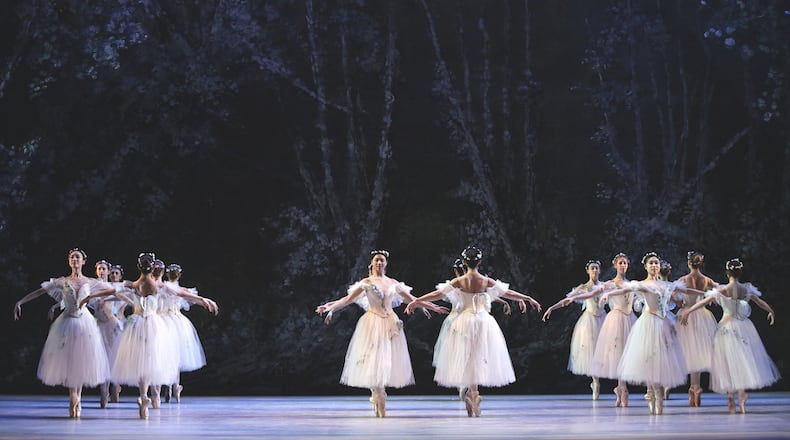“La Sylphide” is the oldest ballet still produced by major companies, but it seems far from antiquated in a fresh, moving and enjoyable new production from the Atlanta Ballet. In mixed programs of recent years, the Atlanta Ballet has often delved into sleek, contemporary work, which certainly has its adherents, but “La Sylphide” is more likely to please ticket-buyers seeking out what the ballet traditionally offers. Rows of graceful ballerinas all in white? Check. A tragic tale of doomed love? Check. Lyrical, liltingly romantic score? Check. Elaborate death scene in which the prima ballerina dies with deliciously dainty grace? Check.
Set in early 19th-century Scotland, “La Sylphide” tells the story of James, who is betrothed to a lovely village girl named Effie. But as the ballet opens, James is awakened from fireside slumber on the morning of his wedding by a beautiful female apparition. Haunted and troubled by the spirit, James’ temper flares when a ragged old woman named Madge creeps in among his guests to warm herself by the fire. Out of revenge, Madge predicts that Effie is actually destined to fall in love with and marry James’ rival, Gurn.
James is eventually lured away from his own wedding day festivities by the spirit, chasing her into a woodland glade where she dances with others of her kind. Madge convinces James that a magic veil will bring the elusive spirit into his arms, but the veil is actually poisoned and kills her. As the ballet ends, James learns that Effie has chosen to marry Gurn, leaving him with nothing.
This new version of Bournonville’s 1836 ballet was staged by Royal Danish Ballet-trained dancer Johan Kobborg, considered one of the foremost contemporary interpreters of the Bournonville tradition. Kobborg worked closely with the Atlanta Ballet to recreate this lively and genuinely moving take on the classic. The narrative elements of the story are often conveyed effectively by pantomime as much as by dance, and this aspect is handled especially well by the company. Several crucial but complicated moments, such as the wedding guests’ slow realization that James has abandoned his own nuptial festivities, are wonderfully effective and dramatic.
No mere painted backdrops, Desmond Heeley’s sets, originally created for American Ballet Theatre’s production, have a lovely sense of depth and dimensionality. A grand staircase, fireplace and large, glass-paned window in James’ baronial home or intertwining, blossoming branches in the woodland glade have a lovely, timeless, fairy tale quality to them, greatly enhanced by designer Joseph R. Walls’ evocative — and often fittingly spooky — lighting.
Under the baton of Tara Simoncic, the Atlanta Ballet Orchestra sounds strongest in appealingly brassy, rhythmic passages of Danish composer Herman Lovenskiold serviceable score, though occasional delicate, lyrical moments shine, as well.
Casts will change throughout the run of the production, but on opening night, Moisés Martin created a romantic, handsome, believably torn James. The dancer struggled on some of Act II’s spinning leaps, but there and elsewhere, he still nonetheless managed to bring an admirable sense of athleticism to the role, a strong, confident quality that emerged especially compellingly in duets with Nadia Maria as a faithful, spirited and earthy Effie. Emily Carrico had a convincingly coy and devious sensuality as the Sylph, but she didn’t evoke the necessary ethereality in her first Act I solo. She more than made up for it with a delicate and genuinely moving death scene. Ensembles, especially the female dancing Sylphs in Act II, were lovely and compelling, though, as often happens in ballet, various country dances in Act I (here in goofy kilts) tended to slow down any sense of narrative urgency.
In Kobburg’s version, the 19th century doesn’t often feel palpably present as it can in other ballets, but this version’s strength often actually lies in its contemporary sense of freshness and clarity. Even those without much familiarity with the ballet can follow the centuries-old story. The fine production’s ultimate air of supernatural mystery and its allegorical tale of a choice between commitment and freedom manage to pack a powerful punch.
PERFORMANCE REVIEW
“La Sylphide”
8 p.m. Feb. 22-23. $20-$130. Cobb Energy Performing Arts Centre, 2800 Cobb Galleria Parkway, Atlanta. 1-800-982-2787, atlantaballet.com.
About the Author
Keep Reading
The Latest
Featured


